| Brünnhilde | Nina Stemme | |
| Siegfried | Ian Storey | |
| Gunther | Gerd Grochowski | |
| Hagen | Andrea Silvestrelli | |
| Waltraute & Second Norn | Daveda Karanas | |
| Gutrune | Melissa Citro | |
| Alberich | Gordon Hawkins | |
| First Norn | Ronnita Miller | |
| Third Norn | Heidi Melton | |
| Woglinde | Stacey Tappan | |
| Wellgunde | Lauren McNeese | |
| Flosshilde | Renée Tatum |

Ashby BART Station
Sunday, I went to San Francisco by BART from Ashby station, which looked rather menacing enough for the set of this masculine Ring Cycle.
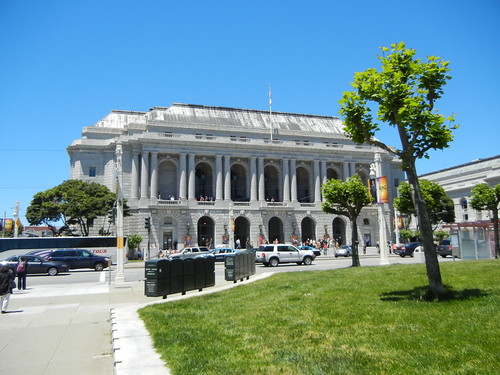
Before the Armageddon
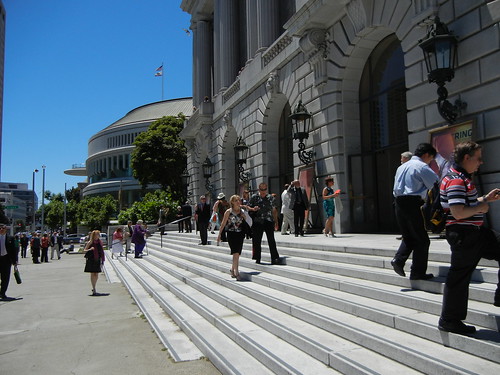
Patrons Arriving
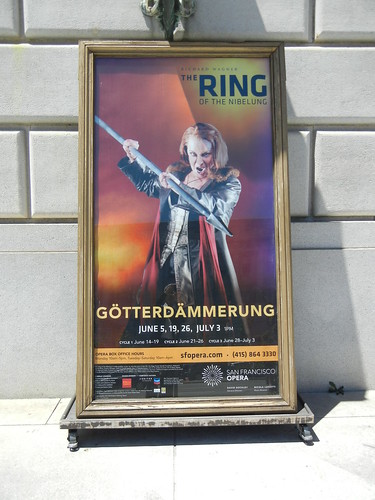
Poster
This opera is the longest one with a prologue and three acts. It started at 1 pm and ended at 5:30 pm, when the curtain calls were over.
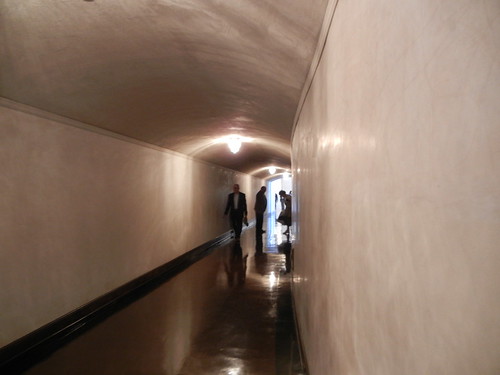
Inside the House
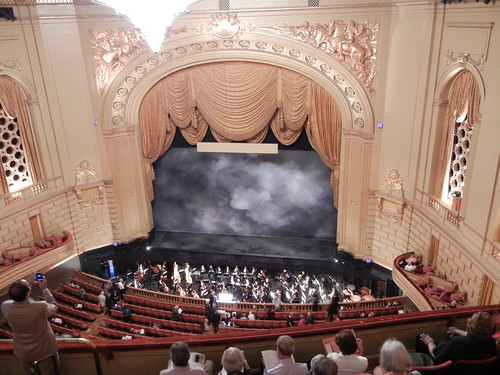
Before Curtain
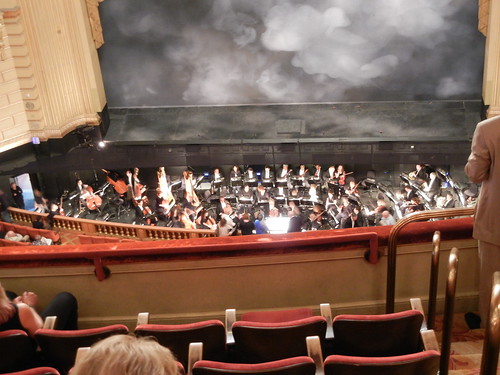
Musicians in the Pit Getting Ready for the Show
The prologue was a scene of three Norns, fate daughters of earth goddess Erda, who spin the fates of everyone, seeing the past, present and future. Here, the set was a integrated circuit board, and the Norns wear bright green coats and dark sunglasses. Instead of spinning, they attached and detached cables to the IC board, to collect or provide knowledge. An interesting idea of integrating digital age. But the idea was not fully exploited and the green coats were plainly garish. This scene should be timeless, mysterious and sad. With three overgrown frogs working out with their arm-thick cables, they were anything but timeless, mysterious or sad. They were actually farcical and the scene was played for laughter. Dramatic situation and lustrous voices wasted. All three Nors sang lustily. Miller's contralto was as formidable as Erda and I really wished I had the stamina to see Cycle 3, which would feature Melton's Sieglinde which surely would be amazing.
Act I started with another awakening scene - this time, both Siegfried and Brünnhilde, from their love-making. Another extended love-duet. Tenor Ian Storey, had very similar physical and facial structure to Jay Hunter Morris, therefore the continuity of the character of Siegfried was ensured, even though their sounds were more different than their appearances, which also made sense, because in Siegfried, he was an absolutely innocent youth, and more tenor sounding Morris provided just that. Here, after having tasted love, more expansive and baritonal Storey demonstrated his increased feelings. He sounded more heroic but less free on top. A trade off. Stemme again, sang gloriously and her statue grew immensely with every single note.
Next scene we found Siegfried's adventure took him to Gibichung Hall, where he was ensnared by Albrech's son Hagen's black magic, fell in love with Hagen's half-sister Guntrune and would capture Brünnhilde for Hagen's half-brother Gunther. This scene was set in a sleek modern living room, without much characters. Some large pipes looming in the background hinted at their wealth perhaps related to fossil fuel.
Hagen, sung by Italian bass Andrea Silverstrelli, was the embodiment of blackness. His music was gloriously dark and scary. Gerd Grochowski and Melissa Citro both sang and acted the flawed but also decent ruling brother and sister well.
Next scene, Brünnhilde was visited by her sister Waltraute (Daveda Karanas), who begged her to give the ring to the Rheinmaidens so as to save Wotan's skin. Brünnhilde, now valued Siegfried's love more than anything and would not let go of the ring, the symbol of the love. Valhalla, which cast her out, meant nothing for her now. Let them perish. They both sang magnificently but some of the physical interactions were ill-timed. For example, Brünnhilde started to push her dear sister away, roughly, even before Waltraute asked her to give up the ring.
Then, Siegfried, disguised as Gunther, came through fire and conquered Brünnhilde and robbed her ring. Putting his sword, Notung, in between, he would spend the night with Brünnhilde, before carry her away next day for Gunther. Strangely, instead of laying down the sword between them and lying down, he dragged Brünnhilde off stage. Rather unnecessary confusion.
When the Act 1 was over, it was past 3 p.m.
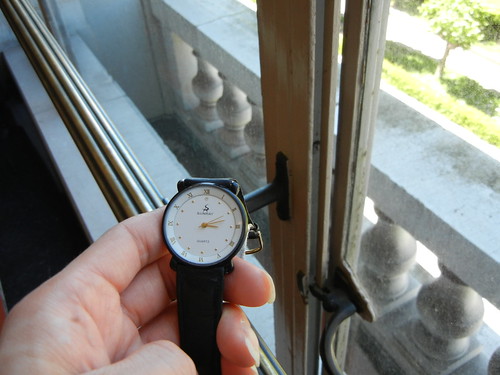
First Intermission
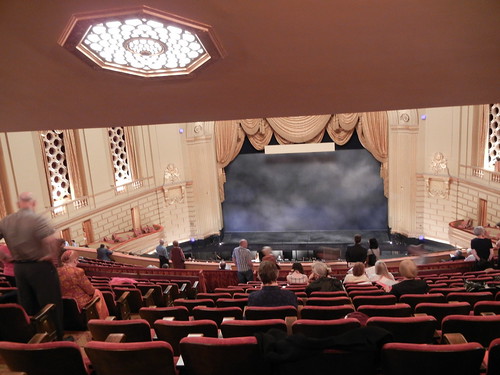
Intermission (Grand Tier)
Act two started with Hagen and Gutrune watching television together, in his bed. Quite ambiguously. It was an interesting twist. Albrech came after Gutrune repulsed Hagen's advances and left the room, and urged Hagen to gain the Ring and its power. Hagen asked Albrech "Der Ewigen Macht, wer erbte sie" ("Who inherits the might of the immortals?"). It was an interesting question and this question stayed with me long after the opera.
Hagen assembled his vassals - here they looked more like underlings of mafia - in act 2 to welcome Gunther's bride. The male chorus sang lustily on and around a platform, which put many soloist on the disadvantage upstage, particularly Siegfried, and during this act, I had to stain to hear him sometimes. Brünnhilde was dragged onto stage, in an ill-fitting gray evening gown. Inexplicably, she was in a pair of ungainly black combat shoes, not even boots. Perhaps, this meant to emphasis her discomfort. Barefoot would have worked better.
The confrontation between Brünnhilde and the supposedly traitor Siegfried was epic and the revenge trio (Brünnhilde, Hagen and Gunther) was the darkest moment of the cycle and the most delicious one. I always enjoyed this stretch the most. However, the physical interaction was not good enough here. They were ill-timed, tentative and brief. Brünnhilde and Gunther barely toughed Hagen's spear before they withdrew their hands, therefore left little impact which should have been tremendous here.

Second Intermission
Before Act 3, General Director David Gockley came up the stage. He was met a round of gratifying applauds. However, he was here to deliver bad news - tenor Ian Storey was vocally indisposed during Act 2, but he would sing for the rest of the performance.
Interestingly, the announcement seemed have lifted his worry, and his vocal productions were freer, clearer and more audible.
The first scene, we found Rheinmaidens, in muddied garbs, collecting garbage littered along the river. Siegfried came during the hunt organized by Hagen, and just about to give up his ring, the Rheinmaidens made a poorly-judged threat and that put the fearless hero off and who decided to keep the supposedly cursed Ring after all. After this scene, I started to doubt, just a bit, my earlier assertive that this production being musical. When Rheinmaidens collected garbage, they made loud noises with their cans, plastic bottles and bags, and sabotaged their lovely singing. To me, any uncalled for extraneous sound was an offense and should be avoided at all costs.
Hagen, Gunther and their vassals joined Siegfried. Hagen cunningly asked Siegfried to tell his past, aided by his potion which restored Siegfried's memory of his love for Brünnhilde. Seizing the opportunity, pushing away the interfering Gunther, Hagen stabbed Siegfried's back, the soft spot betrayed by Brünnhilde, whose love for Siegfried turned to hatred.
Back home, Gutrune longed for Siegfried's horn. When people returned without hearing it, she panicked and Hagen sadistically presented her Siegfried's body. She accused Hagen and Gunther of murder. Hagen then fought Gunther over the ring and broke Gunther's neck and lunged for the ring but Siegfried raised his hand. Here, Zambello misfired badly. Instead of raising his hand either threateningly, defiantly, or in refusal, when confronted by Hagen, here, Siegfried raised hand way before Hagen arrived at his side, and his hand raised at the level perfect for Hagen to reach out. It looked at a complete surrendering.
At this crucial moment, Brünnhilde strode in, followed by Rheinmaidens. All manfolks left the stage. She had learned and understood everything. She and Gutrune reconciled and their sisterhood was quite touching. Another nice touch was the surprise and shock when Rheinmaidens learned that they were to reclaim the gold from Brünnhilde's ashes. Here, the nihilism triumphed. Like father, like daughter.
Following order, Guturne, Rheinmaidens and other women threw logs towards the hidden river bank at the far back of the stage, very noisily, and dumped Siegfried's body there too and dosed with gasoline. Brünnhilde, a torch in hand, walked into the pit behind the stage, and small fire come up there. Scrim fell down, and more flames could be seen, then the square pictures of fallen heroes collected at Valhalla, spiced up by some parts of building blocks, serenely floated down, like over-sized beautiful snowflakes, signify the destruction of Valhalla. It was very anticlimactic.
By now, without a spectacular final denouement, it hardly mattered. However, after seventeen hours, it would be nice to have something to be shocked or marveled at. The pictures of those heroes were all in frontal view, unblemished. Nothing was rotated, twisted, charred, in flame or in smoke.
Then, all cleared up. Hagen was dispatched by a garbage bag on head by the Rheinmaidens - nice touch. They dug out that piece of golden cloth and twirled it about to symbolize the gold and an innocent child brought a young branch and planted it on stage. Rather gratuitously.
Curtain.
The cast were met with thunderous applause. However, Ian Storey met a little bit booing. He came up stage gritted his teeth. I felt it was uncalled for - he did a decent job - not on the level of Nina Stemme but a worthy partner, indisposed or not.
Conductor Runnicles was greeted with enthusiastic applauds. We were truly blessed to have Stemme and Runnicles in this Ring Cycle. They were standing before the second curtain, which now was lifted and revealed the entire orchestra behind it and the theater went nuts.
Nina Stemme then walked to the wing and greeted Francesca Zambello and other creative team members, who were met with applauds and quite loud booing.
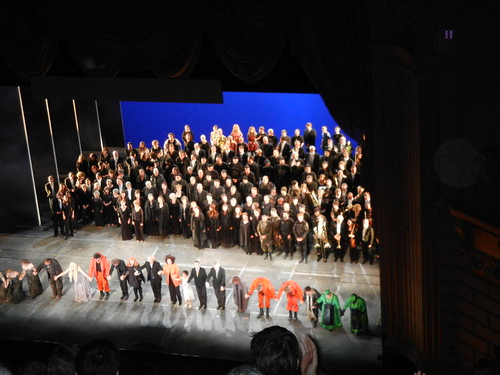
Curtain Call
Curtain Call
The booing was quite baffling. I thought this Ring cycle, conceived by Zambello, was eloquent and interest, totally valid. Her modernistic twist, not always coherent, was always interesting and showed respect to music and texts.
The scenery was largely not very inspired and the costumes were just passable. The video projections between scenes were either irrelevant or too literal and I prefer a blank curtain and imagining drama in my own head. However, it was the interaction amongst the characters and the ability to present the inner conflict, Zambello triumphed. We should be grateful for this, in our age of Spider-Man and Cirque du Soleil.
Was this a perfect Ring? No. Were there rooms for improvement? Many. Was this a Ring for the ages? Probably not. Was it successful? A resounding yes.
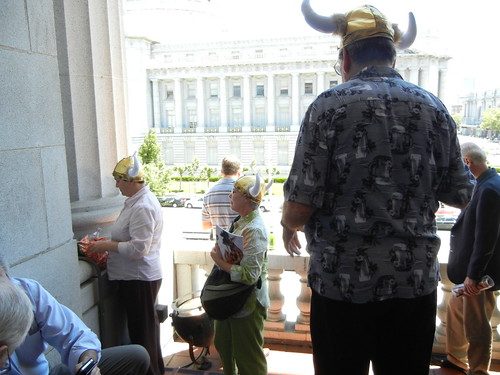
Horned Helmets Off Stage
I suspect that the people who booed Zambello et. al. either felt the production was not bold enough, and or not traditional enough - they wanted their winged helmets and breastplates. I do wish she had pushed the envelop further. The dubbed "American Ring", after these 17 hours, were quite inappropriate, for better for worse. I do felt a deep relief that no "September 11" reference was made. That would trivialize both the event and the operas. It is essentially a universal drama, belonged to human kind.
The ending with the innocent child, didn't work for me. Because it signified a hope which did not exist.
Here, the question regarding who was to inherit the splendor of gods. We? Homo sapiens? Considering the rapidly deterioration of the earth, I'm afraid that we were just as doomed as the occupants of Valhalla.
6:30 p.m., curtain calls ended and we filed out the theater. Exhausted but in exciting mood. I overhead that there was an old lady in her nineties, was in town by herself for all three cycles. Another anecdote I heard was this would be either the 58th or 59th Ring Cycle for another audience member who was also in her or his nineties. Perhaps they were talking about the same person. But I wouldn't be surprised if not.
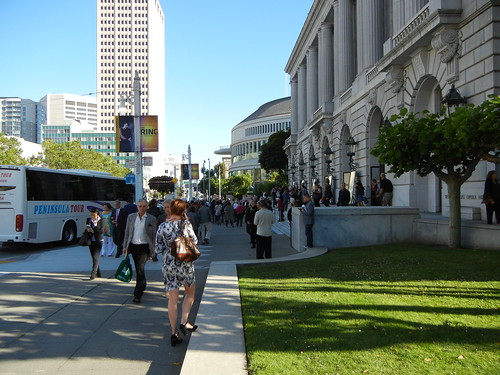
End of the Show
End of the Cycle
7:30 p.m., eight hours after I left home for the opera, I went back home.
My advice for anyone thinking about attending a Ring Cycle: do it at least once. Experiencing them in installments were good enough compromise but the experience of seeing these four operas in close secession was an experience with much greater impact.
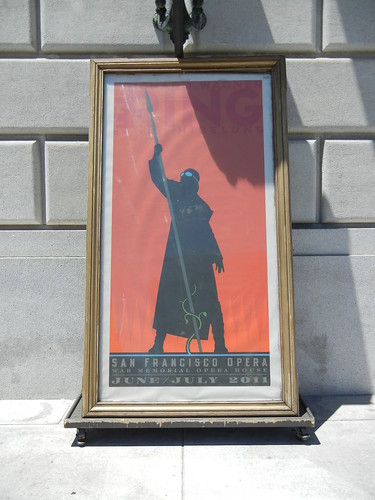
Ring Cycle Poster
San Francisco Opera's website also provided some interesting statistics regarding the Ring Cycle. Such as:
Total number of people involved on stage / in the pit = 415
( 1 conductor + 1 director + 5 designers + 1 choreographer + 30 singers + 94 orchestra + 76 chorus + 52 supers + 115 crew + 30 music and production staff + 10 studio teachers and wranglers (not counting administrative staff, volunteers, ushers, box office staff, etc.)
Total number of people involved on stage / in the pit = 415
( 1 conductor + 1 director + 5 designers + 1 choreographer + 30 singers + 94 orchestra + 76 chorus + 52 supers + 115 crew + 30 music and production staff + 10 studio teachers and wranglers (not counting administrative staff, volunteers, ushers, box office staff, etc.)
Total number of animals = 12 (2 dogs, 1 bear, 1 “bird”, 1 frog, 1 serpent, 6 dead animals)
Total time to complete the Ring = 17 hours.
Related articles:
Part 3, Siegfried - Premiere of Wagner's Ring Cycle at San Francisco Opera
Part 2, Die Walküre - Premiere of Wagner's Ring Cycle at San Francisco Opera
Part 1, Das Rheingold - Premiere of Wagner's Ring Cycle at San Francisco Opera
My Experiences with Wagner's Operas





Thank you for sharing your thoughts and photos - I had a different experience at the end and the little person planting the new ash tree worked for me but maybe I was thinking it is too bad Wagner did not write a 5th section of the Ring and tell us more about the original ash tree.
ReplyDeleteThank you for the above comment - it was an experience to treasure. I also enjoyed meeting my seatmates for multiple times and hear about their Wagner/Ring experience(s). Many people do like the redemptive ending and I do agree that it did have a point. Without hope, life is hard to go on.
ReplyDelete